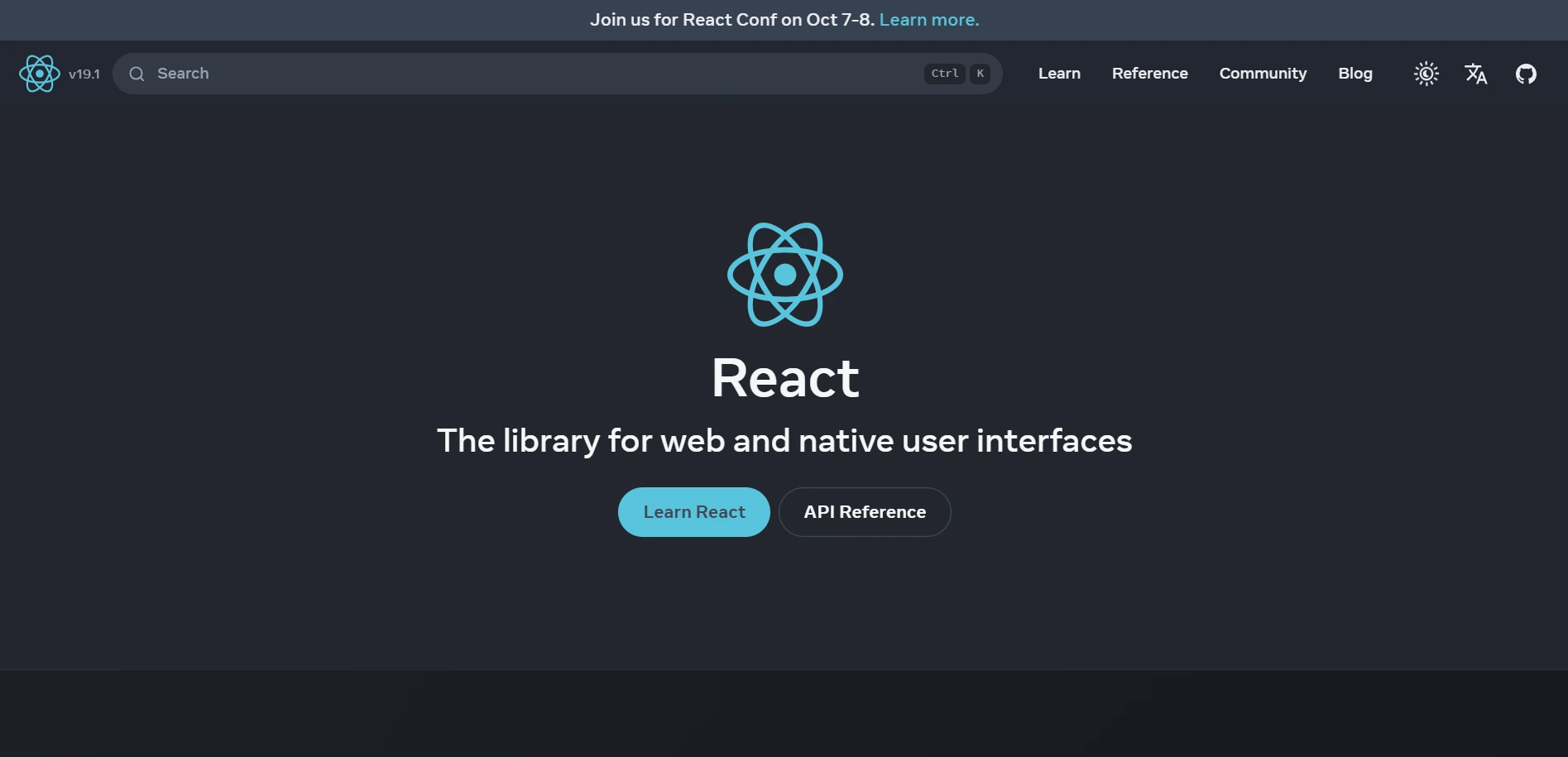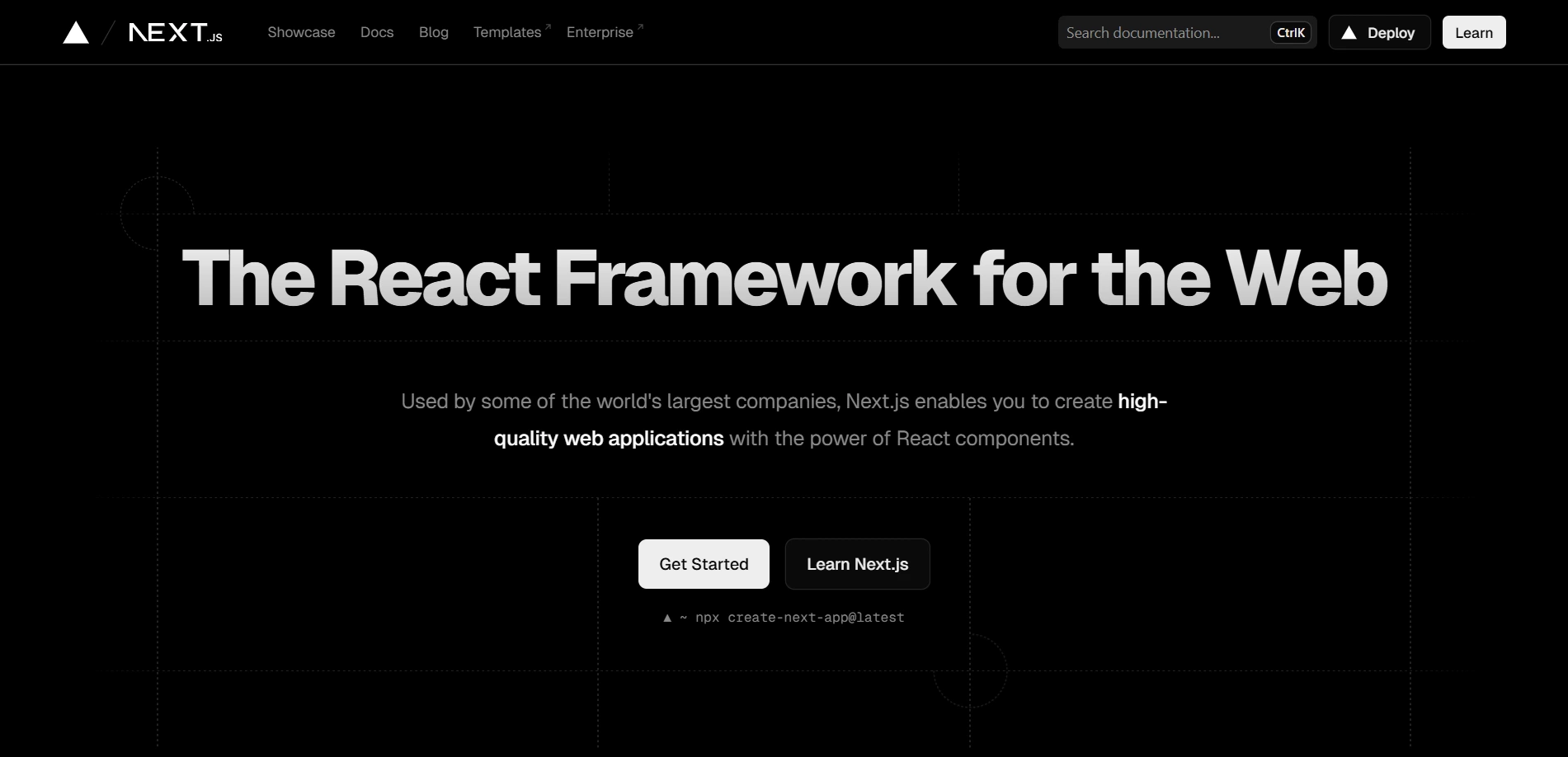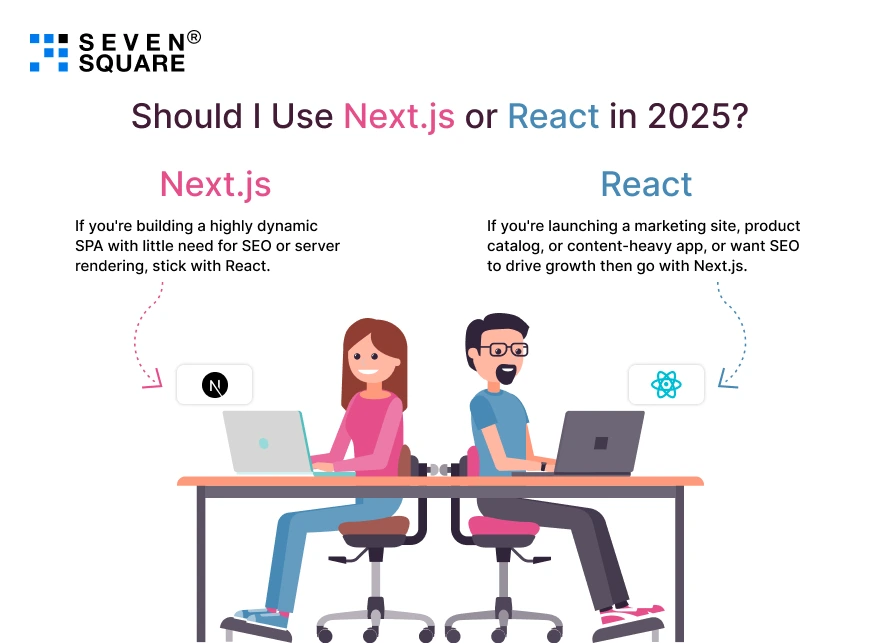“Why is our app so slow on launch day?”
That’s what one of our clients asked us recently, right before they were about to demo their new product to investors.
The frontend was React. The backend was solid. But the speed and SEO? Not so much.
Sound familiar? Whether you’re a startup founder, you’ve probably faced this: Do I stick with React, or go with Next.js?
We’ve seen this debate across industries from logistics to healthcare, ecommerce to SaaS. We’ve built both. We’ve debugged both.
And we know that choosing between React vs Next.js in 2025 is not just about frameworks, it’s about what you’re building, who you’re building it for, and how fast you need it to go live.
Here in this blog, we will try to showcase the Next.js vs React comparison in detail.
We will explain the advantages, disadvantages, and use cases of React and Next.js so you can choose the best framework.
What is React? (The JavaScript Library That Started It All)

React is a JavaScript library developed by Facebook (now Meta) for building user interfaces, particularly for single-page applications (SPAs).
It’s fast, component-driven, and gives you full control over how to manage state, UI rendering, and app structure.
React is ideal when you want maximum flexibility in how your frontend behaves.
It’s perfect for building dynamic UIs and reusable components, especially in applications that don’t need SEO or server-side rendering.
However, React doesn’t come with routing, data fetching, or SEO optimization by default.
If you want these features, you’ll need to bolt them on manually or use frameworks like Next.js, which is essentially React with superpowers.
What is Next.js? (And Why It’s Gaining Traction in 2025)

Next.js is an open-source React framework designed to help developers build production-ready, high-performance web applications with features like Server-Side Rendering (SSR), Static Site Generation (SSG), API routes, and Image Optimization.
In 2025, Next.js vs React is one of the most debated topics among developers and product teams. The reason?
Next.js performance and its SEO capabilities make it a popular choice for businesses who care about both user experience and discoverability on search engines.
Unlike raw React, which is just a library, Next.js is a full-fledged framework. It offers routing, pre-rendering, code splitting, and other optimizations automatically.
If you’re building a blog, eCommerce site, landing page, or even a dashboard, Next.js is an ideal fit when performance and SEO matter.
React vs Next.js: A Quick Comparison
Here you can see a quick React vs Next.js comparison to get an overview of both:
| Feature | React | Next.js |
|---|---|---|
| Type | Library | Full-stack Framework (Built on React). |
| Rendering Options | Client-side only | Server-side, Static, and Client-side. |
| SEO Optimization | Weak (requires workarounds) | Strong (Server-side Rendering & SSG) |
| Performance | Depends on your setup | Optimized out-of-the-box |
| Learning Curve | Moderate | Slightly higher (more tooling involved) |
| Community Support | Massive | Growing quickly |
| Best For | SPAs, fast prototyping | SEO-focused websites, blogs, SaaS apps |
React vs Next.js Performance: Which Is Faster?
- React apps, by default, render everything on the client. This means your users get a blank page at first, while JavaScript loads in the background.
- Next.js, on the other hand, can serve server-side rendered (SSR) or statically generated (SSG) content. That means faster load times and better first contentful paint (FCP).
We once helped a fintech startup move from React to Next.js for their dashboard. Their bounce rate dropped by 20% simply because pages loaded 2 seconds faster.
Who is Winner: If speed and performance matter (and they always do), Next.js wins.
React vs Next.js SEO: Is SEO Important for Your App?
If you’re building a blog, ecommerce site, or landing page, you want Google to index your content quickly.
- React requires client-side rendering. That means bots might miss your content unless you use SSR solutions like Next.js or third-party libraries.
- Next.js was built with SEO in mind. With server-side rendering and static generation, your app is search-engine ready by default.
We worked with a D2C ecommerce brand that was invisible to search engines.
Switching to Next.js gave them an organic traffic boost in 3 weeks without changing a single line of content.
Who is Winner: For SEO-heavy products, Next.js is the smarter choice.
Next.js vs React for Large Web Apps
- If you’re building a content-heavy SaaS dashboard, B2B portal, or anything that needs speed, Next.js gives you a scalable foundation.
- React can also work well, but you’ll spend more time setting up routers, code splitting, performance optimization, and SEO workarounds.
We’ve seen teams using React spend weeks fixing performance issues Next.js handles out of the box.
Our developers love React, but they respect what Next.js offers at scale.
Who is Winner: For scale, Next.js gives you more structure and speed.
What Are the Advantages & Disadvantages of Next.js? (Is It Right for You in 2025?)
Here you can learn about the pros and cons of Next.Js.
Advantages of Next.js:
- Server-side rendering (SSR) out of the box, which improves SEO and initial load time.
- Built-in static site generation (SSG) for fast, secure, and scalable delivery.
- Automatic code splitting and performance tuning.
- File-based routing makes development faster and easier.
- Image optimization, font loading, and TypeScript support are included by default.
- Better suited for blogs, marketing sites, and SEO-heavy apps.
Disadvantages of Next.js:
- Less control compared to pure React if you need fine-grained routing or rendering.
- You need to understand SSR/SSG concepts to use them effectively.
- Dynamic routing and API integration can feel restrictive for some use cases.
- Higher build time for very large static sites.
If you’re comparing React vs Next.js for large web apps, Next.js wins for SEO and speed, but React gives you total flexibility.
What Are the Advantages & Disadvantages of React? (Why It’s Still a Strong Choice?)
Explore the advantages & disadvantages of React to understand why it is the best choice.
Advantages of React:
- Flexible and unopinionated: You choose your routing, styling, state management, etc.
- Large ecosystem and community support.
- Ideal for SPAs (single-page applications) and highly interactive UIs.
- Reusable components make it easier to manage large codebases.
- Supported by major platforms and actively maintained by Meta.
Disadvantages of React:
- No built-in SEO support because it’s client-side by default.
- Doesn’t include routing, state management, or any framework-like features.
- You’ll often need to use extra libraries like React Router, Redux, or Zustand.
- Not suitable for blogs or static content unless paired with SSR frameworks like Next.js.
For teams asking React vs Next.js for SEO, React alone won’t cut it if your product depends on organic traffic.
React vs Next.js for Blogs, Ecommerce, and Dashboards

| Use Case | Recommendation | Why? |
|---|---|---|
| Blog | Next.js | Faster load, static generation, & SEO-friendly. |
| Ecommerce Website | Next.js | Pre-rendering, better for product indexing. |
| Admin Dashboard | React (or Next.js hybrid) | If not SEO-heavy, React works fine. |
| SaaS Landing Page | Next.js | Better SEO, fast initial load, fewer bounce rates. |
How Seven Square Builds Smarter with React & Next.js?
At Seven Square, we don’t just follow frontend trends, we create solutions that scale, convert, and perform using the best-fit tools.
Whether you need the flexibility of React or the built-in power of Next.js, our team ensures your frontend delivers speed, SEO, and stability right from day one.
Here’s how we use React and Next.js to build what your business needs:
When We Use React:
- To build highly interactive SPAs like dashboards, CRMs, and custom admin panels.
- For apps that don’t need SEO, but require fast UI interactions and state-driven behavior.
- When you need component-driven architecture with maximum flexibility.
- For products where your backend is already optimized and frontend rendering is client-side.
- When prototyping fast and iterating quickly is key.
When We Use Next.js:
- For SEO-driven platforms like blogs, marketplaces, and eCommerce sites.
- When server-side rendering (SSR) or static site generation (SSG) can boost load speed and ranking.
- For projects that need fast page loads, better Lighthouse scores, and Core Web Vitals compliance.
- To create landing pages, marketing websites, and scalable SaaS apps.
- When backend APIs and frontend rendering need to work seamlessly (thanks to built-in API routes in Next.js).
Want a React or Next.js solution? Contact Us Now!
Should I Use Next.js or React in 2025?

This is what we tell founders:
- If you’re building a highly dynamic SPA with little need for SEO or server rendering, stick with React.
- If you’re launching a marketing site, product catalog, or content-heavy app, or want SEO to drive growth then go with Next.js.
React vs Next.js is less about one being better & it is more about which is better for you.
React vs Next.js: Final Verdict
| If you want | Use |
|---|---|
| Total flexibility & control | React |
| Built-in routing, SEO, and performance | Next.js |
| Fast SPAs without SEO needs | React |
| Growth via organic traffic | Next.js |
| A clear upgrade path for older apps | Next.js |
Still stuck on “Should I use Next.js or React in 2025?”
Here’s our no-nonsense rule: React if you want flexibility. Next.js if you want velocity.
Still Unsure? Here’s the Smart Way Forward
Whether you choose React or Next.js, decide with intent, not default.
At Seven Square, we believe that great products come from smart decisions made early.
And frameworks are tools, your clarity about the product is what makes them powerful.
So choose what suits your team, your market, and your vision. And if you ever need a hand deciding or building, we’re here.
FAQs
- React is a JavaScript library for building user interfaces, while Next.js is a framework built on top of React.
- React handles the UI part only, whereas Next.js provides extra features like server-side rendering (SSR), static site generation (SSG), routing, and performance optimizations, making it better for SEO and scalability.
- Use React when you’re building single-page applications (SPAs) or internal dashboards that don’t need SEO or server-side rendering.
- React offers more flexibility and freedom if your app doesn’t rely on organic search or fast initial load time.
- Yes because Next.js is built on top of React, migration is smooth.
- You can reuse most of your existing React components, and gradually introduce Next.js features like SSR, routing, and static generation without breaking the app.
- In most cases, Next.js outperforms React because it pre-renders pages on the server and delivers them faster.
- React speed depends on client-side rendering, which may delay the first meaningful paint, especially on slower connections or devices.